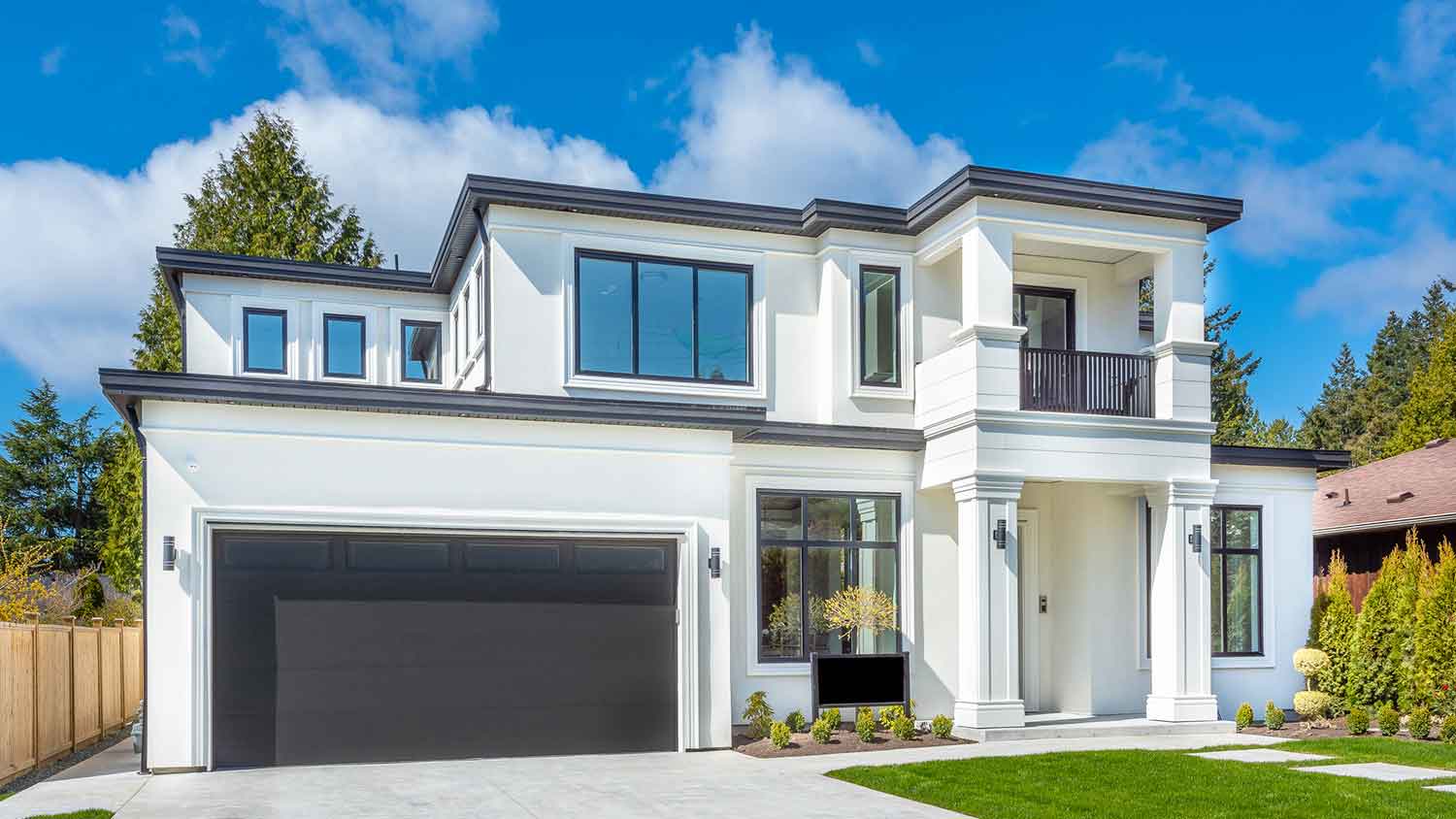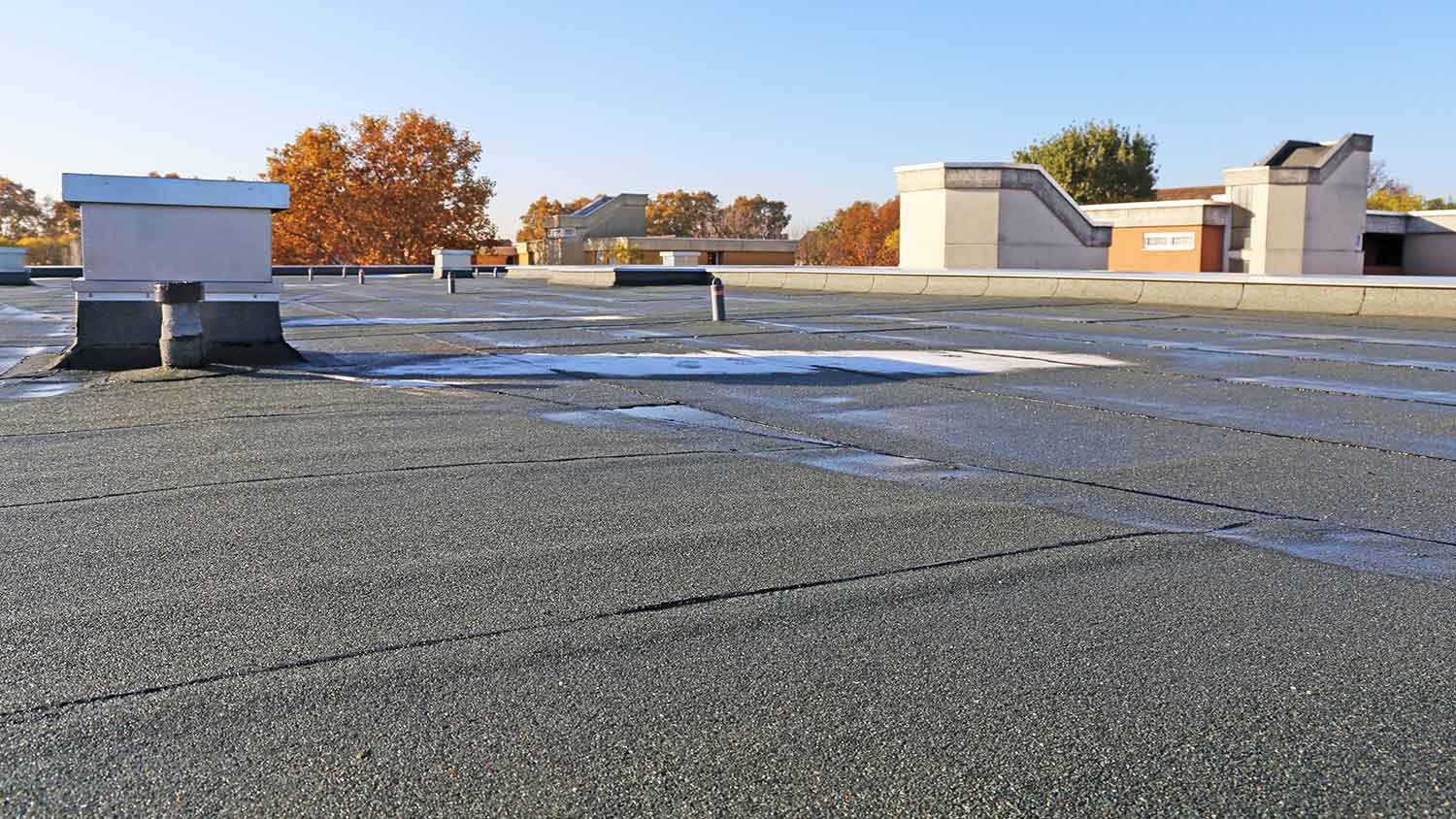Pros and Cons of Spray Foam Roofing: Is This the Right Roof Option for You?
A roofing option that could mean foam-sweet-home


Spray foam roofing is more affordable than most other flat roof options.
It has a longer lifespan than most flat roof alternatives, so it provides greater long-term value at a lower up-front cost.
It’s an uncommon roofing option, so you may struggle to find a professional who can install it.
When it comes to replacing a flat roof, spray foam roofing is an often-overlooked option, but it’s one of the most affordable roofing solutions and boasts a longer lifespan than built-up roofs, TPO roofs, and EPDM roofs. In this guide, we’ll discuss all of the pros and cons of spray foam roofing to help you decide if this is the route you should take for your building.
What Is Spray Foam Roofing?
Spray foam roofing is a unique type of roof with a three-layer application. First, your installer will spray expanding foam over your roof deck or existing roof. The solution expands and creates a layer of highly insulating foam. The roofing professional you hire will then spray on a bottom coat of silicone for protection and then a top coat of silicone. Finally, they’ll spray granules or roof grit onto the top layer of silicone to add texture and protection.
| Pros | Cons |
|---|---|
| Long lifespan | Not widely available |
| Affordable | Hard to install |
| Can go over old roof | Prone to puncture |
| Energy efficiency | Expensive repairs |
| Low risk of leaks | Regular maintenance |
Pros of Spray Foam Roofing

Lifespan
Spray foam roofing lasts for 25 to 30 years with proper maintenance and upkeep. You’ll get more useful life from a spray foam roof than a tar and gravel roof, a TPO roof, an EPDM roof, and most other flat roof options.
Up-Front Cost
Spray foam roofing costs between $4 and $7 per square foot, putting it among the most affordable flat roofing materials available.
| Flat Roof Option | Cost (per Sq. Ft.) |
|---|---|
| Built-up roof | $4–$10 |
| EPDM | $5–$13 |
| Modified bitumen | $4–$8 |
| TPO | $4–$14 |
No Roof Removal Needed
One major benefit of spray foam roofing is that you can install it directly over your existing roof. That means labor contributes less to your roof replacement costs, as you don’t need to pay to have the old roofing material removed before the installation.
Energy Efficiency
The expanding foam that makes up the bulk of a spray foam roof has an R-value of 6.5. This is many times higher than a built-up roof (around 0.35) and single-ply roofing membranes like TPO and EPDM. As a result, a spray foam roof is ideal for maintaining interior temperatures, especially in extreme climates.
Low Risk of Leaks
The double-silicone layer over a spray foam roof means that it’s unlikely to leak unless the roof sustains damage.
Cons of Spray Foam Roofing
Of course, there are some downsides to a spray foam roof that you should consider carefully before deciding if this is the right roof option for you.
Availability
Spray foam roofing is much less prevalent than built-up roofs (BURs) and even TPO and EPDM roofs. As such, you may struggle to find a roofing company near you that has the necessary equipment and experience to install it.
Challenging Installation
A big part of why spray foam roofs are relatively uncommon is how difficult they are to install. They require specialized and expensive equipment, and the application process for the layers of roofing needs to be done properly to maintain good, even coverage and a proper slope for drainage.
Physical Durability
Spray foam is a delicate material compared to many other roofing options, so it’s prone to puncture from physical impact. If you live in an area that sees hail storms and extreme weather that can blow debris onto your roof, this may not be the best option for you.
Repair Costs
Repairing a spray foam roof is more affordable than many other roof materials. However, due to that low physical durability, a spray foam roof will need more frequent repairs, especially if your roof sees a lot of wear and tear from extreme weather. Those repair costs will add up over time.
Ongoing Maintenance
Regular repairs are necessary with a spray foam roof, but you’ll also need bi-annual inspections to check for damage and weaknesses. Regular DIY inspections, especially after severe weather, will also be necessary. Any damage to the thin silicone layers can quickly lead to deterioration of the foam and roof leaks.
Alternatives to Spray Foam Roofing

Spray foam roofing is an option for flat roofs, so be sure to compare it to other flat roof materials before deciding if it’s the best option.
Built-up roof: Built-up roofs have slightly shorter lifespans but greater physical durability. They’re a bit more expensive, and they provide far less insulation.
EPDM: EPDM is more durable than spray foam roofing, but it’s more expensive to repair and provides less insulation. It can also be up to twice as expensive to install.
Modified bitumen: Modified bitumen roofs cost the same as spray foam roofs, but they only last for 20 years. However, repairs are less frequent.
TPO: TPO is a good option for hot climates but isn’t as energy-efficient as spray foam roofs in colder climates. TPO has a much shorter lifespan and similar durability, but it can be up to twice the cost to install and is more costly to repair.
Is Spray Foam Roofing for You?
Spray foam roofing might be the ideal option for your flat roof if you live in an area that sees extremely cold or hot temperatures and infrequent severe weather. It’s the most insulative and energy-efficient type of flat roof, but blown debris and hail can quickly lead to issues. If you don’t see severe weather often, a spray foam roof will likely give you the most value for your money.
Spray foam roofing is also a good option to consider if you want a low installation cost and don’t mind carrying out more frequent maintenance.
Frequently Asked Questions
A spray foam roof costs an average of $6,000 to install, making it one of the most affordable flat roofing options available. Costs can increase if you have a complex roof design with many roof vents or have a roof that’s larger than average. While up-front costs are relatively low, keep in mind that ongoing maintenance and repairs tend to be more expensive than you’d see with other flat roof materials.
Installing a spray foam roof over your existing roof can stop roof leaks, as the foam and silicone encapsulate the parts of your flat roof below and keep water away from your building materials. Spray foam roofs don’t stand up well to impact, though, so if you live in an extreme climate that could expose your roof to hail or blown debris, you could see roof damage and resulting leaks after severe weather.





- Roofers
- Metal Roofing
- Roof Repair
- Roof Inspection
- Vinyl Siding Repair Contractors
- Flat Roofing Companies
- Commercial Roofing
- Emergency Roofing Companies
- Leaky Roof Repair
- Metal Roof Repair
- Business Roof Repair
- Flat Roof Repair
- Tile Roof Repair
- Slate Roofers
- Rubber Roofers
- Roofing & Siding
- Metal Roof Installation
- Affordable Roofing
- Roof Sealing
- Attic Ventilation Contractors










